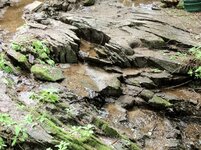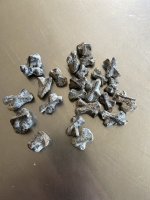You are using an out of date browser. It may not display this or other websites correctly.
You should upgrade or use an alternative browser.
You should upgrade or use an alternative browser.
classifier and screen sizes
- Thread starter stilllookin
- Start date
dunc
Full Member
The mesh # is how many squares per linear inch in the classifier. So 30 would have 30 squares per linear inch which would obviously be bigger than 50 mesh.
dunc
Full Member
I was actually going to start a new thread but I can probably post this question here. I have found a creek that is producing nothing but flour gold. I have never found anything that won't go through a flour sifter when I do my cleanup. My question is what is the smallest classifier I should be using before sluicing. This is in the ca. mother lode and I am getting everything from pebbles to large rocks in every shovel full if that matters.
I want to classify it down as much as possible without wasting too much time or losing too much gold.
I want to classify it down as much as possible without wasting too much time or losing too much gold.
stilllookin
Jr. Member
- Thread starter
- #4
Thanks dunc
The thing I don't understand is the plus and minus sign preceeding the size. Are you saying a +50 woul be maybe a 30? It sounds like where you are a 1/2 classifier would be good for you. But I'm in Vermont and we don't look for anything larger than a pin head.
The thing I don't understand is the plus and minus sign preceeding the size. Are you saying a +50 woul be maybe a 30? It sounds like where you are a 1/2 classifier would be good for you. But I'm in Vermont and we don't look for anything larger than a pin head.
AU Seeker
Bronze Member
- Oct 14, 2007
- 1,329
- 982
- Detector(s) used
- E-Track, MXT, CZ6A
- Primary Interest:
- All Treasure Hunting
Stilllookin,
The +/- means, if you use a #4 (approx. 1/4") classifier, anything that is still in the classifier is the +, anything that goes through the classifier is the -.
Usually you would start with depending on your gold say a #2 (approx. 1/2") classifier (start with the next size larger than the biggest gold that you are mining/finding) and continue through the the different sizes up to 100 to 400 mesh when doing your final cleanups, anything smaller than 400 mesh is not worth the time it takes to recover the gold unless you have a commercial operation and mining micro gold, and then you would be recovering the gold with chemicals.
Most people don't use anything smaller than 100 mesh.
Skip
The +/- means, if you use a #4 (approx. 1/4") classifier, anything that is still in the classifier is the +, anything that goes through the classifier is the -.
Usually you would start with depending on your gold say a #2 (approx. 1/2") classifier (start with the next size larger than the biggest gold that you are mining/finding) and continue through the the different sizes up to 100 to 400 mesh when doing your final cleanups, anything smaller than 400 mesh is not worth the time it takes to recover the gold unless you have a commercial operation and mining micro gold, and then you would be recovering the gold with chemicals.
Most people don't use anything smaller than 100 mesh.
Skip
stilllookin
Jr. Member
- Thread starter
- #6
Thank You Skip
I would never have guessed what the +/- would have meant. In my situation I classify with #4 for my small sluice, run the concentrates through a 30 and finish with a 50 for the blue bowl. It seems to work ok. I don't believe I'll ever find a nugget so big it won't go through a # 4 but will keep checking.
Wayne
I would never have guessed what the +/- would have meant. In my situation I classify with #4 for my small sluice, run the concentrates through a 30 and finish with a 50 for the blue bowl. It seems to work ok. I don't believe I'll ever find a nugget so big it won't go through a # 4 but will keep checking.
Wayne
Sam Burgin
Jr. Member
- May 10, 2008
- 40
- 1
The finest sluice known to man for capturing fine gold is the Popandson sluice. The end. Period.
It captures 97% of everything down to 150 mesh. The most researched sluice on the planet.
All you need is a slope of an inch or so per foot, moderate water flow, and classify down to 2 mesh, 4 mesh is better.
Sam
It captures 97% of everything down to 150 mesh. The most researched sluice on the planet.
All you need is a slope of an inch or so per foot, moderate water flow, and classify down to 2 mesh, 4 mesh is better.
Sam
Re: classifier and screen sizes I'm in Adirondacks, NY!
Hey,
I'm in Indian Lake, NY. 30+ miles to VT border. I'm still looking too! I have read that Rutland & Windsor County are the best shot for chance of finding color. I'm also retired and have dredging experience in CA. Call 518-648-0456 or [email protected]. Hope to hear from you! Gene
Hey,
I'm in Indian Lake, NY. 30+ miles to VT border. I'm still looking too! I have read that Rutland & Windsor County are the best shot for chance of finding color. I'm also retired and have dredging experience in CA. Call 518-648-0456 or [email protected]. Hope to hear from you! Gene
utah1066
Full Member
Here is a link wow look at this show and it will show you how to and what to buy, have fun
Walt
http://www.prospectingchannel.com/motherlode.html
Walt
http://www.prospectingchannel.com/motherlode.html
calisdad
Bronze Member
Sam Burgin said:The finest sluice known to man for capturing fine gold is the Popandson sluice. The end. Period.
It captures 97% of everything down to 150 mesh. The most researched sluice on the planet.
All you need is a slope of an inch or so per foot, moderate water flow, and classify down to 2 mesh, 4 mesh is better.
Sam
Thanks for the heads up Sam. Great read with stats here: http://gpex.ca/smf/index.php?topic=4159.0
vtgoldprospector
Jr. Member
- Jun 27, 2012
- 74
- 7
- Detector(s) used
- Google Earth, my hands and a pan!
- Primary Interest:
- Prospecting
My current prospecting is focused in Vermont where the gold is typically smaller grains. I find as a good balance for big enough to catch the gold but small enough to eliminate much of the refuse without having to screen my a$$ off is a #2, a #4 then a #12. It nicely reduces the volume with very little risk of loosing gold. Additional screening smaller than a #12 becomes time consuming and risks a loss of some of the pickers or sub-pickers. Optimally, reduce it to a #4 or #12 and pack it out. Doing the panning/processing at home is easier and always yields better (less loss).

Gold Map Maker -- Create your own gold map!

Gold Map Maker -- Create your own gold map!
Top Member Reactions
-
 2317
2317 -
 1123
1123 -
 1043
1043 -
 897
897 -
 833
833 -
 774
774 -
 753
753 -
 739
739 -
 606
606 -
 508
508 -
 493
493 -
 476
476 -
 450
450 -
 420
420 -
 396
396 -
O
395
-
 394
394 -
 387
387 -
 383
383 -
 376
376
Users who are viewing this thread
Total: 2 (members: 0, guests: 2)




